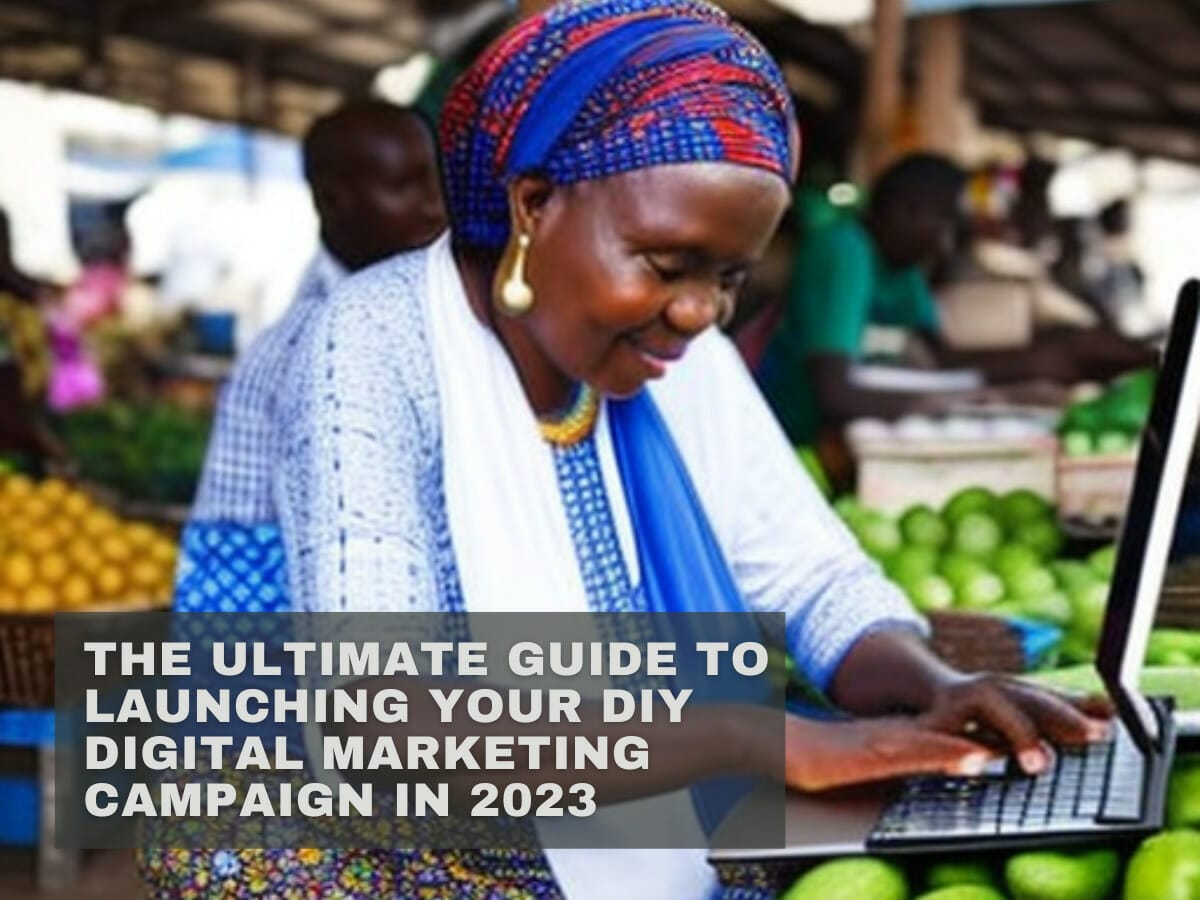Introduction to DIY Digital Marketing in 2023
Welcome to the world of DIY digital marketing! As we enter 2023, the digital marketing landscape continues to evolve, and businesses of all sizes are looking for ways to stay ahead of the curve. With the rise of self-reliant marketing strategies, DIY digital marketing has emerged as a popular and cost-effective solution for businesses looking to expand their online presence.
In this guide, we will explore the ins and outs of DIY digital marketing, covering everything from the basics to advanced strategies, tools, and techniques. By the end, you will be well-equipped to launch your own successful DIY digital marketing campaign and take your business to new heights.
So, buckle up and get ready to embark on an exciting journey filled with tips, tricks, and expert advice to help you master the art of DIY digital marketing.
Understanding the basics of DIY Digital Marketing
Before diving into the world of DIY digital marketing, it’s essential to understand the basics. Digital marketing encompasses a wide range of online marketing strategies and tactics, all geared towards promoting your business and driving targeted web traffic to your website, social media profiles, or any other online platform.
Some of the most common digital marketing channels and techniques include search engine optimization (SEO), pay-per-click (PPC) advertising, social media marketing, content marketing, and email marketing. By executing these strategies effectively, you can attract more potential customers, generate leads, and ultimately, increase sales.
The key to successful DIY digital marketing lies in understanding your target audience, setting clear goals and objectives, and selecting the right mix of channels and tactics to achieve those goals. With the right plan in place, you can take control of your marketing efforts and achieve impressive results on a budget.
Creating a DIY digital marketing plan

A well-crafted digital marketing plan is the foundation of any successful DIY digital marketing campaign. It helps you stay organized, track your progress, and ensure that all your efforts are aligned with your overall business goals. Follow these steps to create your own DIY digital marketing plan:
-
Set clear goals: Begin by defining your campaign objectives. These goals might include increasing brand awareness, driving website traffic, generating leads, or boosting sales. Make sure your goals are specific, measurable, attainable, relevant, and time-bound (SMART).
-
Define your target audience: Understand who your ideal customers are by creating detailed buyer personas. This will help you tailor your marketing messages and target your campaigns more effectively.
-
Choose your digital marketing channels: Based on your goals and target audience, select the appropriate digital marketing channels that will help you achieve those objectives. These may include SEO, PPC, social media, content marketing, and email marketing.
-
Create a budget: Determine how much you’re willing to spend on your DIY digital marketing campaign. Allocate your budget across different channels and tactics, keeping in mind the potential return on investment (ROI) for each.
-
Develop a content strategy: Plan and create high-quality, engaging content that resonates with your target audience. This may include blog posts, social media updates, emails, videos, and more.
-
Monitor and measure: Track the performance of your DIY digital marketing efforts and adjust your plan as needed to optimize results.
DIY Social Media Marketing strategies
Social media platforms such as Facebook, Instagram, LinkedIn, and Twitter offer businesses a unique opportunity to connect with potential customers and build brand awareness. Implementing effective DIY social media marketing strategies can help you reach your target audience and drive engagement with your brand. Here are some tips to get started:
-
Choose the right platforms: Focus on the social media platforms that are most popular among your target audience, and where your content is most likely to be seen and shared.
-
Create shareable content: Develop engaging, informative, and entertaining content that encourages users to like, comment, and share your posts. This might include images, videos, infographics, and blog articles.
-
Leverage hashtags: Use relevant and trending hashtags to increase the visibility of your content and reach a broader audience.
-
Engage with your audience: Respond to comments and messages, ask questions, and participate in conversations to build relationships with your followers.
-
Promote your content: Share your blog articles, videos, and other content on your social media profiles to drive traffic back to your website.
-
Track your performance: Monitor your social media analytics to understand what’s working and what’s not, and adjust your strategy accordingly.
DIY SEO: Tools and Techniques
Search engine optimization (SEO) is the process of improving your website’s visibility in search engine results pages (SERPs) for relevant keywords. By implementing effective DIY SEO strategies, you can increase organic traffic to your website and boost your online visibility. Here are some DIY SEO tools and techniques to help you get started:
-
Keyword research: Use keyword research tools like Google Keyword Planner, SEMrush, or Moz Keyword Explorer to identify popular and relevant keywords for your business.
-
On-page optimization: Optimize your website’s content, meta tags, URLs, and headings with the right keywords to improve its visibility in search results.
-
Technical SEO: Ensure your website loads quickly, is mobile-friendly, and has a clear site structure to help search engines crawl and index your pages more efficiently.
-
Link building: Generate high-quality backlinks to your website by creating shareable content, guest blogging, and engaging with influencers in your industry.
-
Local SEO: Optimize your Google My Business listing and other local directory profiles to improve your visibility in local search results.
-
Monitor your progress: Use SEO analytics tools like Google Analytics, Google Search Console, or Moz Pro to track your website’s performance and make improvements as needed.
Content marketing for your DIY digital marketing campaign
Content marketing is a crucial element of any DIY digital marketing campaign. By creating and distributing valuable, relevant, and consistent content, you can attract and engage your target audience, ultimately driving them to take a desired action. Here are some content marketing strategies to consider:
-
Blogging: Write informative and engaging blog posts that answer your target audience’s questions and provide valuable insights. Share your blog posts on social media and email newsletters to boost their reach.
-
Video marketing: Create engaging videos that showcase your products, services, or industry expertise. Share these videos on platforms like YouTube, Vimeo, and social media to reach a wider audience.
-
Infographics: Design visually appealing and informative infographics that break down complex topics into easily digestible chunks. Share your infographics on social media, blog posts, and email newsletters to increase engagement.
-
Podcasts: Record and share audio podcasts that discuss industry trends, share tips, or feature interviews with industry experts. Promote your podcasts on social media and through email marketing.
-
Ebooks and whitepapers: Develop in-depth ebooks and whitepapers that provide valuable information on a specific topic. Offer them as lead magnets in exchange for your audience’s contact information.
Email marketing in your DIY marketing campaign
Email marketing is a powerful and cost-effective way to connect with your target audience, nurture leads, and drive conversions. Here are some tips to help you leverage email marketing in your DIY digital marketing campaign:
-
Build your email list: Encourage website visitors to sign up for your email list by offering valuable incentives like ebooks, discount codes, or exclusive content.
-
Segment your list: Categorize your subscribers based on their interests, preferences, and behaviors to send more targeted and relevant email campaigns.
-
Design engaging emails: Create visually appealing and mobile-friendly email templates that reflect your brand identity and convey your message effectively.
-
Craft compelling subject lines: Write attention-grabbing subject lines that entice your subscribers to open your emails and read your content.
-
Personalize your emails: Use personalization techniques like addressing subscribers by their first name or sending tailored content based on their preferences.
-
Monitor your performance: Track email open rates, click-through rates, and conversion rates to measure the effectiveness of your email campaigns and make improvements as needed.
Pay-Per-Click (PPC) advertising for DIY marketers
PPC advertising involves bidding on keywords and placing ads on search engine results pages or other websites. When users click on your ad, you pay a fee to the platform. Here are some tips for running a successful DIY PPC campaign:
-
Choose the right platform: Select the most suitable PPC platform for your business, such as Google Ads, Bing Ads, or Facebook Ads.
-
Conduct keyword research: Use keyword research tools to identify relevant and high-converting keywords for your PPC ads.
-
Create compelling ad copy: Write engaging and persuasive ad text that highlights the unique benefits of your products or services and encourages users to click on your ad.
-
Optimize your landing pages: Ensure your landing pages are relevant to your ad copy and keywords, and are designed to encourage visitors to take a desired action.
-
Set a budget: Determine how much you’re willing to spend on your PPCcampaign, and allocate your budget across different ad groups and campaigns.
-
Monitor and optimize: Regularly track your ad performance, and adjust your ad copy, targeting, and bidding strategies as needed to improve your ROI.
Analyzing and measuring your DIY digital marketing success
To ensure the success of your DIY digital marketing campaign, it’s essential to monitor your progress and measure your results. Here are some key metrics to track:
-
Website traffic: Monitor the number of visitors to your website, and track where they’re coming from, how long they’re staying, and which pages they’re visiting.
-
Conversion rates: Measure the percentage of website visitors who take a desired action, such as filling out a form, making a purchase, or subscribing to your email list.
-
SEO rankings: Track your website’s ranking in search engine results pages for relevant keywords.
-
Social media engagement: Monitor the number of likes, comments, shares, and followers on your social media profiles.
-
Email marketing metrics: Track open rates, click-through rates, and conversion rates for your email campaigns.
-
PPC metrics: Monitor your ad impressions, click-through rates, cost per click, and conversion rates for your PPC campaigns.
By regularly analyzing and measuring these metrics, you can gain valuable insights into what’s working and what’s not, and make data-driven decisions to optimize your DIY digital marketing campaign.
Tips and best practices for a successful DIY digital marketing campaign
Here are some additional tips and best practices to help you succeed with your DIY digital marketing campaign:
-
Stay up-to-date with the latest trends and techniques: Keep abreast of the latest developments in digital marketing by following industry blogs, attending webinars, and participating in online communities.
-
Focus on quality over quantity: Rather than trying to be everywhere at once, focus on delivering high-quality content and experiences on a select few channels that are most effective for your business.
-
Test and iterate: Experiment with different tactics, channels, and messaging to see what works best for your target audience, and continually refine your approach based on your results.
-
Stay organized: Use project management and collaboration tools to stay organized, track your progress, and ensure that everyone on your team is on the same page.
-
Stay patient and persistent: Digital marketing is a long-term game, and it takes time and effort to see results. Stay patient, stay persistent, and keep refining your strategy until you achieve your goals.
Conclusion and next steps for your DIY Digital Marketing journey
Congratulations! You’ve made it to the end of our Ultimate Guide to Launching Your DIY Digital Marketing Campaign in 2023. Armed with the knowledge, tools, and techniques outlined in this guide, you’re now ready to take your DIY digital marketing efforts to the next level.
Remember, DIY digital marketing is all about taking control of your marketing efforts, and leveraging the power of digital channels to achieve your business goals. By staying focused, staying organized, and staying patient, you can achieve impressive results and take your business to new heights.
So, what are you waiting for? It’s time to put your new skills and knowledge to the test and launch your own successful DIY digital marketing campaign. Good luck, and happy marketing!



